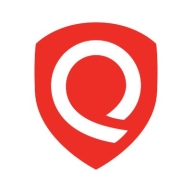


Qualys VMDR and RedSeal are competing in the cybersecurity solutions space. Qualys VMDR holds an edge in pricing and customer support, offering a budget-friendly solution with strong service, while RedSeal's advanced capabilities make it a comprehensive choice, justifying its cost with valuable features.
Features: Qualys VMDR enhances vulnerability management with real-time threat intelligence, automated workflows, and seamless integrated deployment. RedSeal provides comprehensive network visualization, risk prioritization, and advanced situational awareness, emphasizing network security analysis as a key differentiator over Qualys VMDR.
Room for Improvement: Qualys VMDR can enhance its feature set to offer deeper network insights and extend its security analysis. RedSeal could improve by simplifying its deployment process and streamlining its extensive feature set to be more accessible to less tech-savvy users. Both could enhance user interfaces for a more intuitive experience.
Ease of Deployment and Customer Service: Qualys VMDR boasts an easy, cloud-based deployment paired with responsive support for straightforward setup. RedSeal, though more complex initially due to its features, offers solid support to ease deployment challenges, ensuring effective user experience despite complexities.
Pricing and ROI: Qualys VMDR's competitive pricing focuses on optimizing ROI with efficient resource use and integration. RedSeal demands higher initial costs but promises substantial long-term ROI through detailed network insights and management. Qualys VMDR is cost-effective for budget-conscious users, while RedSeal delivers value for those seeking thorough security analysis.
| Company Size | Count |
|---|---|
| Small Business | 20 |
| Midsize Enterprise | 12 |
| Large Enterprise | 69 |
| Company Size | Count |
|---|---|
| Small Business | 1 |
| Midsize Enterprise | 1 |
| Large Enterprise | 7 |
Zafran Security integrates with existing security tools to identify and mitigate vulnerabilities effectively, proving that most critical vulnerabilities are not exploitable, optimizing threat management.
Zafran Security introduces an innovative operating model for managing security threats and vulnerabilities. By leveraging the threat exposure management platform, it pinpoints and prioritizes exploitable vulnerabilities, reducing risk through immediate remediation. This platform enhances your hybrid cloud security by normalizing vulnerability signals and integrating specific IT context data, such as CVE runtime presence and internet asset reachability, into its analysis. No longer reliant on patch windows, Zafran Security allows you to manage risks actively.
What are the key features of Zafran Security?
What benefits can users expect from Zafran Security?
In industries where security is paramount, such as finance and healthcare, Zafran Security provides invaluable protection by ensuring that only exploitable vulnerabilities are addressed. It allows entities to maintain robust security measures while allocating resources efficiently, fitting seamlessly into existing security strategies.
Vulnerability Management, Detection, and Response (VMDR) is a cornerstone product of the Qualys TruRisk Platform and a global leader in the enterprise-grade vulnerability management (VM) vendor space. With VMDR, enterprises are empowered with visibility and insight into cyber risk exposure - making it easy to prioritize vulnerabilities, assets, or groups of assets based on business risk. Security teams can take action to mitigate risk, helping the business measure their actual risk exposure over time.
Qualys VMDR offers an all-inclusive risk-based vulnerability management solution to prioritize vulnerabilities and assets based on risk and business criticality. VMDR seamlessly integrates with configuration management databases (CMDB), Qualys Patch Management, Custom Assessment and Remediation (CAR), Qualys TotalCloud and other Qualys and non-Qualys solutions to facilitate vulnerability detection and remediation across the entire enterprise.
With VMDR, users are empowered with actionable risk insights that translate vulnerabilities and exploits into optimized remediation actions based on business impact. Qualys customers can now aggregate and orchestrate data from the Qualys Threat Library, 25+ threat intelligence feeds, and third-party security and IT solutions, empowering organizations to measure, communicate, and eliminate risk across on-premises, hybrid, and cloud environments.
RedSeal’s network modeling and risk scoring platform builds an accurate, up-to-date model of an organization’s entire, as-built network to visualize access paths, prioritize what to fix, so you can target existing cybersecurity resources to protect your most valuable assets. With RedSeal’s Digital Resilience Score, decision makers can see the security status and benchmark progress toward digital resilience.
We monitor all Risk-Based Vulnerability Management reviews to prevent fraudulent reviews and keep review quality high. We do not post reviews by company employees or direct competitors. We validate each review for authenticity via cross-reference with LinkedIn, and personal follow-up with the reviewer when necessary.